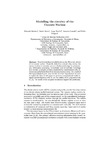Mostrar o rexistro simple do ítem
Modelling the circuitry of the cuneate nucleus
| dc.contributor.author | Sánchez Vila, Eduardo | |
| dc.contributor.author | Barro Ameneiro, Senén | |
| dc.contributor.author | Mariño Alfonso, Xurxo | |
| dc.contributor.author | Canedo Lamas, Antonio | |
| dc.contributor.author | Vázquez Muñíz, Pablo José | |
| dc.date.accessioned | 2005-11-17T18:02:28Z | |
| dc.date.available | 2005-11-17T18:02:28Z | |
| dc.date.issued | 1999 | |
| dc.identifier.citation | International Work-Conference on Artificial and Natural Neural Networks, IWANN'99, Alicante, Spain, June 2-4, 1999 : proceedings, José Mira, Juan V. Sánchez-Andrés (eds.). Lecture notes in computer science, vol. 1606 (1999), p. 73-85 | es_ES |
| dc.identifier.issn | 0302-9743 | |
| dc.identifier.uri | http://hdl.handle.net/2183/230 | |
| dc.description.abstract | Experimental data recorded in cat "in vivo" offer a new picture of the cuneate nucleus. Clasically definied as a simple relay station, the cuneate nucleus is currently seen as a fundamental stage in somatosensory information processing. Intracellular and extracellular recordings have revealed a complex circuitry estabished by cuneothalamic cells, interneurons and afferent fibers from the sensorimotor cortex. As a result of electrophysiological work, some circuits have been hypothesized in order to explain the data. In this paper we present a computational model designed and developed in order to test the validity of the proposed circuit in [15]. The results of the computer simulations support the predictions. | es_ES |
| dc.format.mimetype | application/pdf | |
| dc.format.mimetype | text/plain | |
| dc.language.iso | eng | es_ES |
| dc.publisher | Springer | es_ES |
| dc.rights | The original publication is available at www.springerlink.com | es_ES |
| dc.rights | The original publication is available at www.springerlink.com | |
| dc.title | Modelling the circuitry of the cuneate nucleus | es_ES |
| dc.type | info:eu-repo/semantics/article | es_ES |
| dc.rights.access | info:eu-repo/semantics/openAccess | es_ES |
Ficheiros no ítem
Este ítem aparece na(s) seguinte(s) colección(s)
-
GI-NEURO - Artigos [165]






